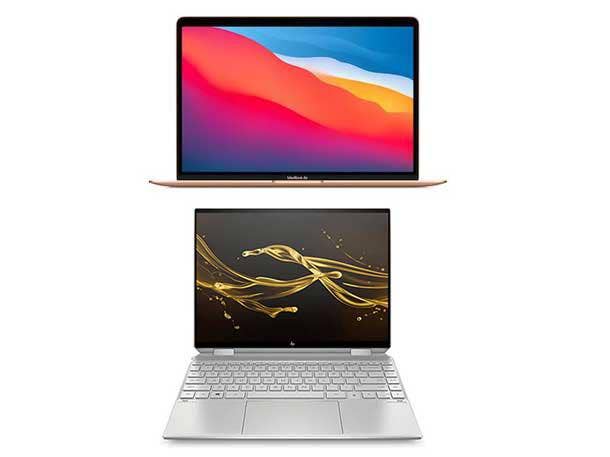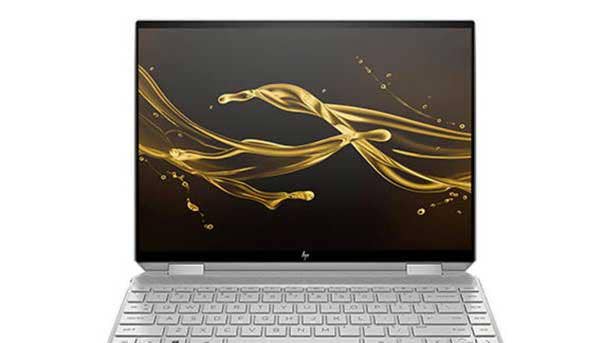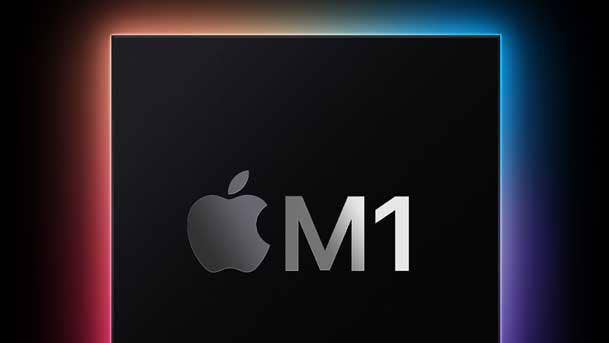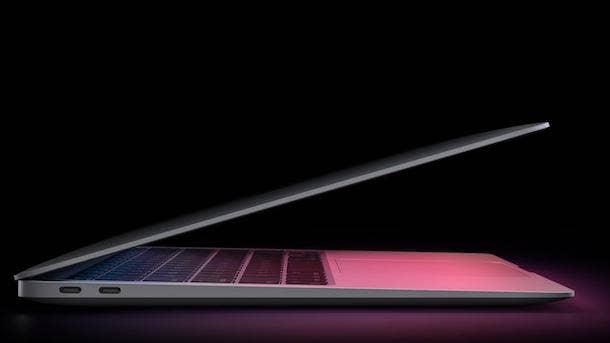Apple MacBook Air (M1) Vs. HP Spectre x360 14 (Intel)
The CRN Test Center compares the latest MacBook Air, featuring Apple’s M1 chip, with HP’s Spectre x360 14, powered by 11th-Gen Intel Core processors.

MacBook Air Vs HP Spectre
For a new laptop that combines strong performance and battery life with portability and an appealing design, two of your best options in 2021 are Apple’s MacBook Air with M1 and the HP Spectre x360 14. On performance, the new MacBook Air moves up to Apple’s speedy M1 chip, while HP’s Spectre x360 14 adds 11th-gen Intel Core processors (Core i5 or i7) for a performance boost. Both laptops also include premium displays and keyboards, more than a typical day’s worth of battery life and a portable design. But there are some key differences between the MacBook Air and HP Spectre x360 14 that buyers should take note of—including on price—which we’ll be covering in this post.
Which of these two notebooks is the best fit for you? In the following slides, the CRN Test Center compares Apple’s MacBook Air (M1) vs HP’s Spectre x360 14 (Intel 11th Gen) on specs, features and price.
Display and Keyboard
HP’s Spectre x360 14 offers slightly more display space, at 13.5 inches, than the 13.3-inch screen on the MacBook Air M1. The Spectre’s display stands out in a few other ways too—including with an option for a vibrant OLED display with 3,000 x 2,000 resolution and up to 400 nits of brightness. LCD display options for the notebook include 1,920 x 1,280 resolution with either 400 nits, or with 1,000 nits and an integrated privacy screen. The Spectre x360 14 is also a 2-in-1 convertible laptop, with a touch screen that can be flipped part or all of the way around. Additionally, the display features a 3:2 aspect ratio display, which HP claims will provide about 20-percent greater room for vertical viewing than a display with a 16:9 aspect ratio.
The MacBook Air doesn’t offer OLED or a touch screen option, but the use of Apple’s popular Retina display technology promises top-notch picture quality for the notebook. Apple has also introduced support for P3 wide color on the MacBook Air—which provides “an even more vibrant, true-to-life Retina display,” the company said. The resolution for the M1 MacBook Air falls in between the options on the Spectre x360 14, at 2,560 x 1,600, while the display matches the 400 nits of brightness found on two of the three Spectre x360 models. Of course, like every other Mac on the market, the MacBook Air does not offer a touch screen option and is not convertible.
For the keyboard, both laptops include upgraded keyboard designs from some past models in their respective lineups. HP touts its notebook as the “first Spectre with an all-in-one keyboard,” meaning that it includes keys such as a power button, new camera shutter button and mic mute key, along with a fingerprint reader. The Spectre x360 keyboard offers 1.5 mm of key travel, providing deeper keys than on the MacBook Air, which has 1 mm of key travel. Still, the MacBook Air offers a more-comfortable keyboard over the previous butterfly keyboard design, by using Apple’s Magic Keyboard design.

Portability and Design
HP does have one other display-related advantage to boast about. The laptop has been designed to have very slim bezels around the screen—resulting in a screen-to-body ratio of 90.3 percent, according to HP. Along with offering nice aesthetics, that design choice also helps to enable a compact all-around size for the Spectre x360 14. The MacBook Air continues to feature thicker bezels around the display, and the screen-to-body ratio for the notebook has been reported at 69.5 percent.
Still, even with the minimal size of the Spectre x360 14 overall, the MacBook Air is thinner and lighter—though not by a staggering amount. The MacBook Air measures 0.63 of an inch thick and weighs 2.8 pounds, while the Spectre x360 14 measures 0.67 of an inch thick and weighs 2.95 pounds.
In terms of materials, both notebooks are made from aluminum. The MacBook Air is available in three colors—gold, silver or space gray—while the Spectre x360 14 is offered in black (“with Copper Luxe accents”), blue (“with Pale Brass accents”) and silver.

Processor and RAM
The newest MacBook Air is among the first crop of devices to feature Apple’s high-performance, Arm-based M1 processor. For the MacBook Air, there are two options for the M1—a version that has a seven-core GPU or a variant with an eight-core GPU. Both versions have an eight-core CPU, with four cores focused on demanding tasks and four cores that enable battery efficiency for less-intensive tasks.
As mentioned, HP’s Spectre x360 14 comes equipped with 11th-gen Intel Core processors. Choices include the 11th-gen Core i5 and i7, which both feature four cores. The top-level configuration comes with Intel’s Core i7-1165G7.
Benchmark scores point to a performance advantage for the MacBook Air with M1, even when it’s facing off with the fastest Spectre x360 14. Geekbench 5 scores for the M1 and the Core i7-1165G7 show the M1 coming out ahead in both single-core and multi-core benchmarks. The M1’s speed advantage should be most obvious on more-demanding, multi-core tasks, according to the Geekbench 5 results.
On RAM, both laptops offer options for 8 GB or 16 GB of RAM.

Battery Life, Collaboration and Ports
Both the MacBook Air with M1 and the Spectre x360 14 are juggernauts on battery life. Apple promises 18 hours of battery life on the M1-powered MacBook Air, and notebook doesn’t have a fan, either. HP promises nearly the same amount—up to 17 hours of battery life—for the Spectre x360 14.
On collaboration, the MacBook Air with M1 adds Apple’s latest image signal processor. That enhances the image quality on the 720p FaceTime HD webcam, “with better noise reduction, greater dynamic range, and improved auto white balance and ML-enhanced face detection so users look their best during video calls,” Apple says. The MacBook Air also features stereo speakers with Dolby Atmos support and three mics with “directional beamforming” for improved quality.
The webcam on the Spectre x360 14, the HP TrueVision HD IR Camera, also offers 720p resolution. The notebook offers fewer mics, with a dual-mic array, but double the speakers, with four speakers from audio specialist Bang & Olufsen. The Spectre x360 14 also comes with AI-powered noise removal capabilities (leveraging Intel GNA 2.0), “to mute any background noise automatically across communication apps Microsoft Teams and Zoom and audio outputs and inputs like speakers, headphones, and the mic,” HP says.
One area where the Spectre x360 14 stands out is on ports options. The notebook offers two Thunderbolt / USB-C ports and one USB-A port (which features a “drop-jaw” design, due to the thin form factor of the laptop). The Spectre’s USB-A port also offers a “SuperSpeed” 5Gbps signaling rate, while the laptop comes with a microSD card reader, as well. The M1 MacBook Air, on the other hand, only includes two ports—and both are USB-C / Thunderbolt.

Price
Apple’s MacBook Air with M1 comes out as the more affordable laptop in this comparison, with the starting MacBook Air price at $999. That makes it $170 cheaper than the starting price for the HP Spectre x360 14, which starts out at $1,169.99. However, as noted earlier, the Spectre x360 14 with the Core i7 processor will be most comparable to the MacBook Air with M1 on performance (though it still doesn’t quite match the M1 on speed). To get the Spectre x360 14 with Core i7, you’ll need to pay another $150—totaling $1,319.99—or about $320 more than the MacBook Air.
One additional note: pricing will vary for the Spectre x360 14 based on the display choice, as well—with the OLED display option adding $170 to the price. Selecting the integrated privacy screen will increase the price by $80.